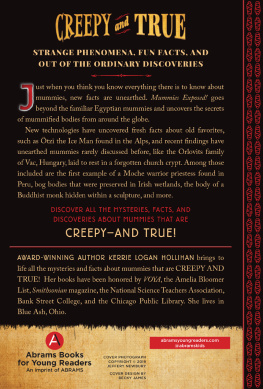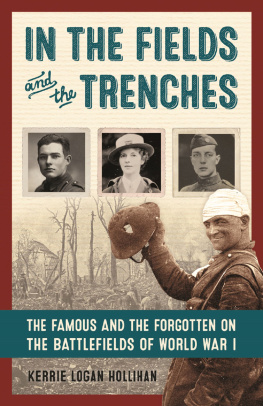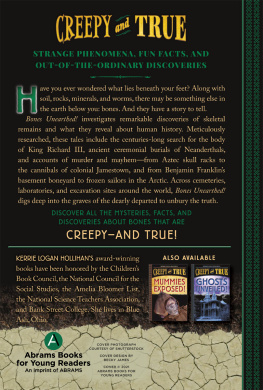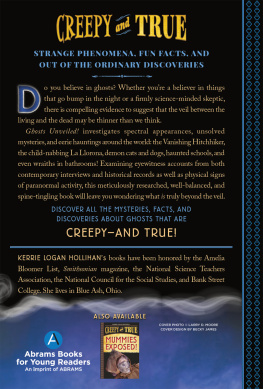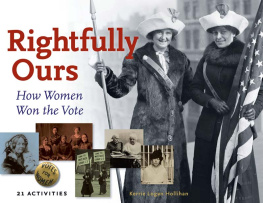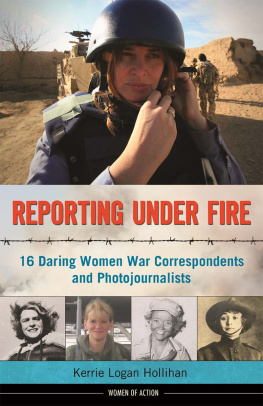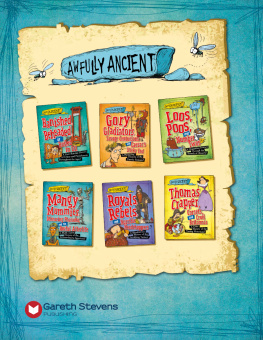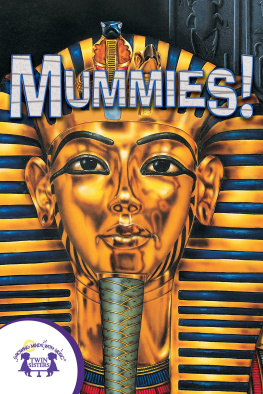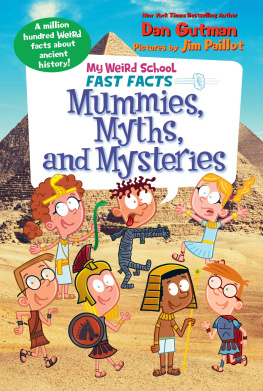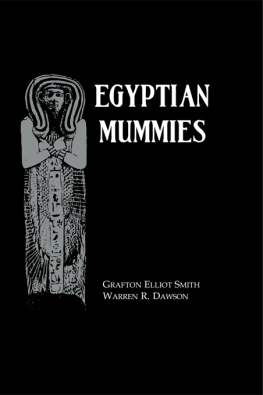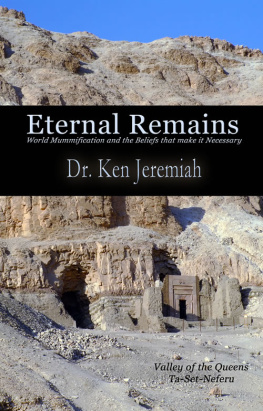
To young readers who ask questions and the
grownups who help them find answers
Library of Congress Cataloging-in-Publication Data
Names: Hollihan, Kerrie Logan, author.
Title: Mummies exposed! / by Kerrie Logan Hollihan.
Description: New York: Abrams Books for Young Readers, 2019. | Series: Creepy and true; #1 | Includes bibliographical references and index.
Identifiers: LCCN 2018014310 | ISBN 9781419731679 (hardcovert) | ISBN 978-1-68335-375-1 (eISBN)
Subjects: LCSH: MummiesJuvenile literature.
Classification: LCC GN293 .H65 2019 | DDC 393/.3dc23
Text copyright 2019 Kerrie Logan Hollihan
Book design by Becky James
For picture credits, see .
Published in 2019 by Abrams Books for Young Readers, an imprint of ABRAMS. All rights reserved. No portion of this book may be reproduced, stored in a retrieval system, or transmitted in any form or by any means, mechanical, electronic, photocopying, recording, or otherwise, without written permission from the publisher.
Abrams Books for Young Readers are available at special discounts when purchased in quantity for premiums and promotions as well as fundraising or educational use. Special editions can also be created to specification. For details, contact specialsales@abramsbooks.com or the address below.
Abrams and Creepy and True are registered trademarks of Harry N. Abrams, Inc.

ABRAMS The Art of Books
195 Broadway, New York, NY 10007
abramsbooks.com

When most people think of a mummy, they think of a body wrapped again and again in cloth, like this Egyptian mummy of a youth (80100 AD ). However, there are many other kinds of mummies.
INTRODUCTION
The invitation read something like this:
You are cordially invited to attend the Unwrapping of a Mummy
Thursday, May 7, 1908
The Hall of Chemistry
Manchester University, England

Five hundred peoplescholars and ordinary men and womencrowded into that lecture hall to watch and learn from Margaret Murray, an English archaeologist. It was the first time a woman had unrolled a mummy in front of a crowd, and her candidate was a doozy. Khnum-Nakht was one of two brothers she studied. He had lived and died during Egypts Middle Kingdom days about four thousand years ago. A report said:
Khnumu Nekht [as Murray spelled it] was bared of his wrappings and brought once more to the light of day... Near the body the linen sheets had rotted, and they fell to pieces at a touch. The bones, however, were more or less perfect. There were traces of flesh on them. It was on the whole a gruesome business, and one or two people left early.
Those one or two, and others perhaps, felt in their bones that Margaret Murray was working on a human being who had once been alive. They understood that Khnum-Nakht had laughed and loved, enjoyed family meals, hung out with friends, celebrated holidays, had stomach aches, and knew fear and joy... exactly like them. Exactly like you.
Archaeology, the study of ancient history, was a brand-new field in 1908. Before that, Murray scoffed, it was merely the pastime of... the amateur who amused himself by adding beautiful specimens to his collection of ancient art.
Murray was right. For centuries, wealthy Europeans had ventured to Egypt, coming home with mummy souvenirs to show off. And more. Artists ground mummy parts for paint to create a special tint called mummy brown. Along with rags of all sorts, mummies went to mills to be crushed and turned into paper. Doctors prescribed powdered mummy medicine for their patients aches and pains.

Archeologist Margaret Murray (at table) during a public lecture in 1908. She was likely the first woman to unwrap a mummy.
Powdered mummy? Blech! But doctors had done so for ages, possibly due to a mix-up in someones dictionary. Mm is the old Persian word for a sticky wax. Its a natural product found in oil sands and pitch lakes.
Mm moved into other languages, and mumia became a term for bitumen, that smelly, gooey stuff used in asphalt driveways and parking lots. Bitumen, aka mumia, also served as a drug to heal all kinds of ancient ailments, from rashes to toothaches to broken bones.
Unlike mummies, languages are flexible. When folks laid eyes on Egypts mummies, the bodies black coating looked like bitumen, like mumia. (Sometimes it was bitumen; other times, it was not.) It wasnt much of a stretch to call one of these wrapped-up bodies a mummy. Over hundreds of years, people started to believe that mummy wrappings and mummies themselves were powerful medicine. This belief stuck with us into the early 1900s.
Then theres the mummys curse, another belief thats stuck around. If youve read about historys best-known mummy, King Tutankhamun (Tut) of ancient Egypt, then you might know about the curse. Within six years of Tuts discovery in 1922, at least ten people linked to the mummy died. The very first was Lord Carnarvon, the English earl who bankrolled the project to find Tuts tomb. He died of an infected mosquito bite even before he cast eyes on the mummy.
Had eager archaeologists insulted the boy kings spirit? Newspapers ran stories about King Tuts curse, and many believed in it for years. Some still do.
When Margaret Murray died in 1963, she was one hundred years old. She saw plenty of change in her life, as humans invented and used telephones, televisions, X-ray machines, cars, and airplanes. People were dreaming of sending humans to the Moon.
Today we text on our phones, use robots for surgery, and talk about sending ourselves to Mars. Time moves on and knowledge multiplies. Its the same with archaeology. When Murray was a girl, archaeologists didnt have modern tools such as X-ray imaging, carbon dating, and DNA sampling. Since then, all these techniques have helped us to flesh out the lives of mummies.

Howard Carter and an Egyptian workman examine King Tuts third and innermost coffin of gold, which sits inside the second coffin case.
Today in the United States, archaeology is but one branch of a much bigger field of study called anthropology. Its likely that if Margaret Murray were at work today, shed call herself an anthropologist.
Anthropos is a Greek root word meaning human. The suffix ology means study.
So there you have it. Anthropology is the study of human beings and their cultureshow we live our livesacross timefrom prehistoric days to the presentand across spaceall around our world.
Mummies are our very best link to the past. Studying mummies is an anthropologists dream.
Stories about King Tutankhamun abound in books and other media. No doubt about it; King Tut is Number One. But in this book, youll meet other, equally fascinating mummieshow they
Next page
